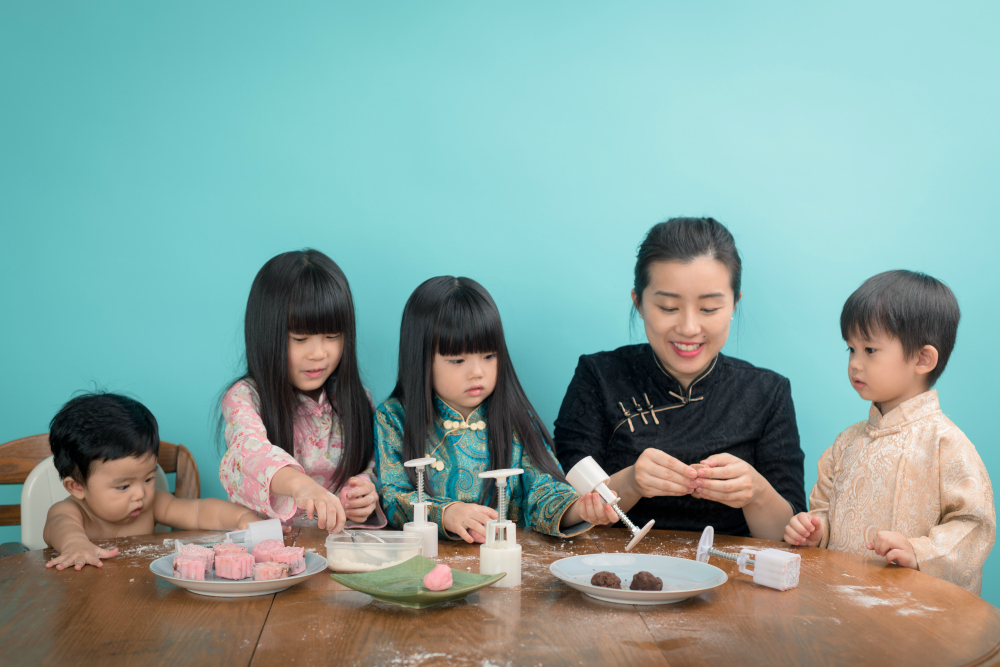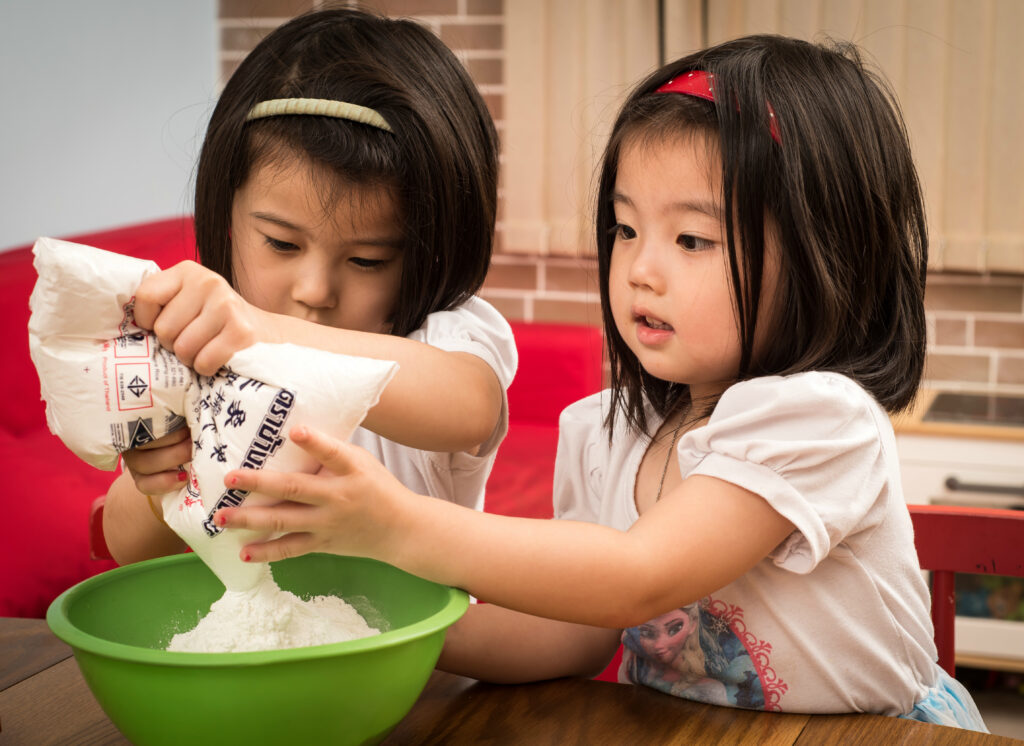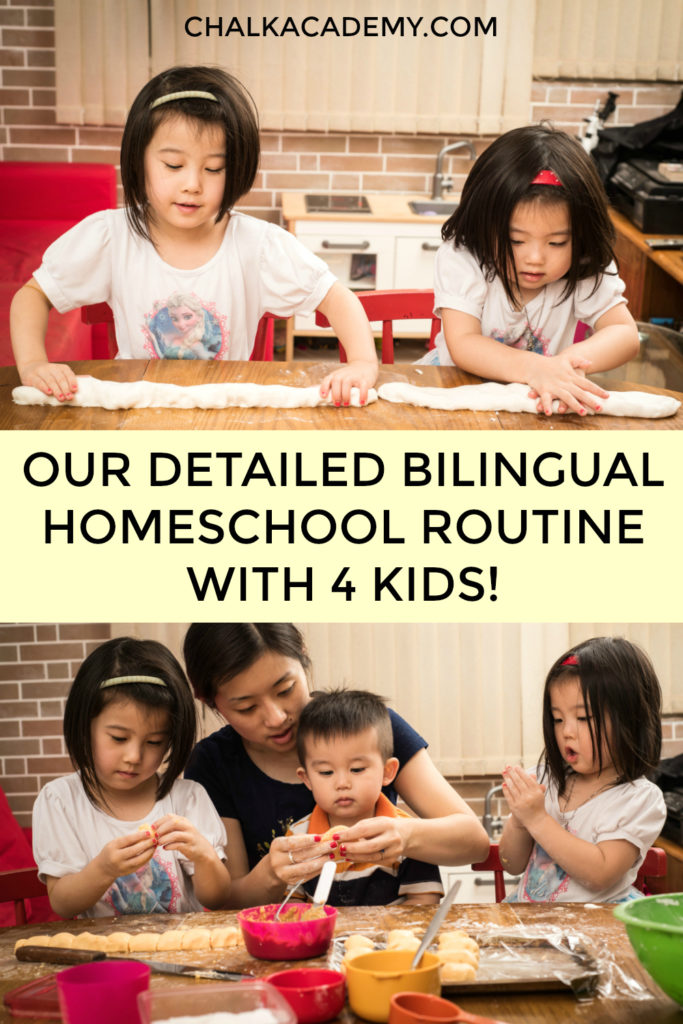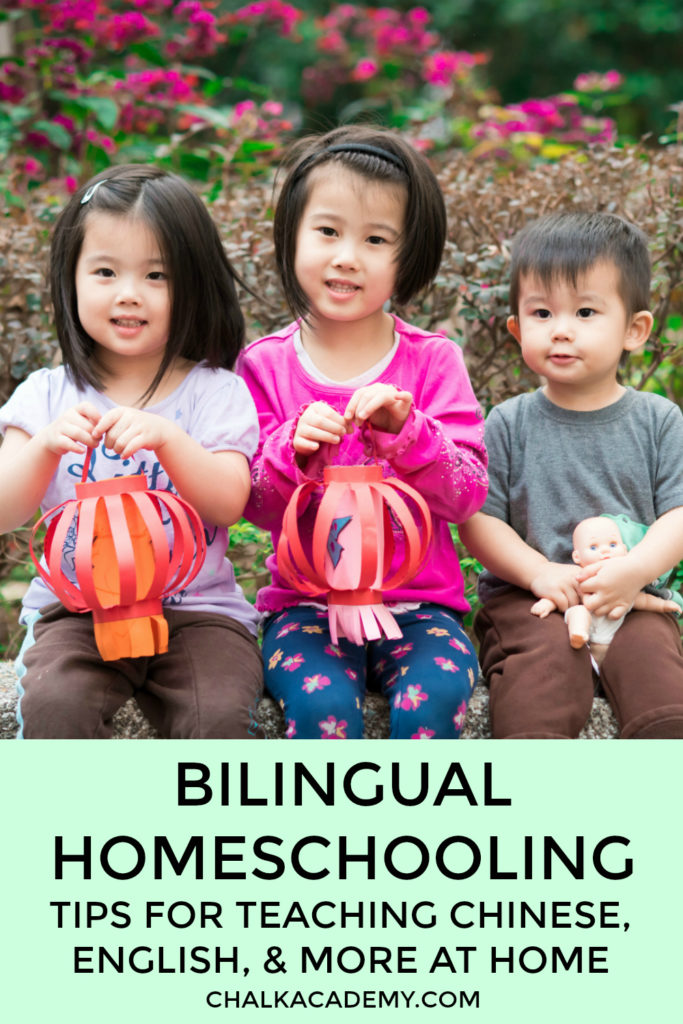Bilingual Homeschooling: A Mother of 4 Shares Her Schedule and Advice

Bilingual homeschooling can be challenging, and I know this because we are doing it part-time. However, homeschooling can be the best option for families who want their children to enjoy learning Chinese and English in a flexible, individualized, and authentic setting.
When Po Tim King reached out to me and asked if she could share about bilingual homeschooling here, I was excited to learn about her experience! Po Tim King is an education blogger, and she homeschools her children full-time in Cantonese and English. Inspired to help other families raise bilingual children, she creates educational Chinese games, crafts, and activities.
Here, she shares her family’s motivation, schedule, and advice for homeschooling and raising multilingual children!

Tell us about your bilingual homeschooling family!
I was born and raised in Hong Kong. My parents speak Cantonese; I learned English at school. I was educated like all Hong Kong kids with heavy load of daily homework, frequent tests, exams, plus attending different extracurricular classes, tutoring and other training.
After high school, I was fortunate to get accepted into a university in the United States, and it changed my life.
My husband is also from Hong Kong and speaks English, Cantonese, and Mandarin. We have four kids ages 8, 6, 4, and 1. They have been exposed to Cantonese and English since birth.
What was your teaching experience prior to bilingual homeschooling?
Teaching Cantonese
During college, I taught Cantonese to missionaries. For the first time, I really began to understand my language. I learned how to explain and teach my native language using various activities and exercises.
Teaching Mandarin Chinese
After I finished my major in Linguistics and minors in TESOL and music, I taught in a Chinese immersion elementary school in Utah, United States. I taught Chinese art and music in Mandarin Chinese. I also helped with the Chinese New Year event at school, held a summer camp for the immersion students, and was the choir director.
Working with teachers and kids in the United States was a blast. It was shocking to see how American public schools were run compared to schools in Hong Kong. It was nice to see how fun and enjoyable school was for kids.

Why did you decide to homeschool your children in Hong Kong?
In 2014, my bilingual homeschooling journey started when we moved from the United States to Hong Kong. Our hope was to immerse our children in Chinese culture.
At the time, my oldest child was 4 years old. We put her in a preschool for half a semester, and it turned out to be a huge mistake. Her behavior at home dropped, and she was angry and frustrated all the time after school. Plus, my husband and I didn’t agree with how Hong Kong schools run. In the end, we pulled her out of school.
I started researching homeschooling and child development. It was refreshing to learn how children naturally learn through play and exploration, and how sitting in a classroom all day isn’t what kids need.
I reflected on my own experiences and compared what I had learned from other homeschooling families and the traditional Hong Kong educational system. It was easy to see that bilingual homeschooling was the best learning environment for my children.
Try this: Kids Art Cart, Storage System, and Organization Tips
What did you hope can be different about learning through bilingual homeschooling?
When I went to school, it was boring and rigid. Now, my main focus is to make sure kids enjoy learning Chinese. Reading, speaking, and writing Chinese is not forced.
I would like to have more purpose for my kids learning Cantonese. I would love to make Cantonese real in their lives, that they need to use it to survive and help others. For example:
- Translate/explain something from English into Cantonese
- Figure out how to order food in the Chinese restaurant on their own
- Teaching English to an old Chinese lady
At first, fun methods and a play-based learning system were a foreign concept to me. I didn’t always feel confident using this teaching method. However, when we have a sense of purpose and duty, it will motivate us to learn with confidence and excitement.
What are some benefits of bilingual homeschooling in Hong Kong?
Freedom of everything
Schedules and school days, curriculum and subjects, methods and approach of teaching, how fast and slow to teach each lesson, etc. Pretty much I get to decide everything.
For example, my kids are good at reading English and can go for the chapter books and classics earlier. However, my kids didn’t start learning Chinese reading until age 6 years, so they are still reading simple Chinese books now.
Meet my kids and family needs
Since there is no standard, we don’t need to worry about bothering others. We can follow my kids’ interests, learning style, development, and ability.
What challenges have you experienced with homeschooling 4 bilingual kids?
Different duration of school time
Each kid has different duration of school. Some of them may start playing while others still working.
Make sure tasks are not too complicated
Most of the time my older kid can follow the instructions and learn mostly on their own. I only need to help with my 2 younger kids. If I have planned something too complicated, my kids will need my help at the same time, and it will turn into chaos right away.
Easy to speak English during chaos
When someone is crying, getting angry with others, or doesn’t want to have school, it’s so easy to speak and explain things in English.

Bilingual homeschooling routine in Hong Kong
Before I show you our bilingual homeschooling routine, I would like to make sure you understand this is just a reference. Try it out if you would like. However, being flexible to fit your family needs is most important. I have changed my bilingual homeschooling routine and schedule almost every year, sometimes 3 or 4 times a year.
Kids change all the time physically and mentally. I am sure you have experienced your kid suddenly becoming more independent, or your kids suddenly don’t want to sleep, or your kids becoming very frustrated and angry all the time, or your kids lose interest in learning in certain subjects and skills, etc.
Try this: Empower Kids with a Visual Daily Routine Chart in English, Chinese, Korean
Our Bilingual Homeschooling Schedule (Weekdays)
- 8:00 – 8:30 am Get up; My kids make their beds, get ready for breakfast, independent reading
- 8:30 – 9:00 am Breakfast; English / Cantonese audio or video of Bible
- 9:00 – 9:30 am My 3 older kids have chores: clean table, wash dishes, sweep floor, so I can get ready for school.
- 9:30 – 11:00 am Homeschooling; 15-30 mins English/ Chinese printable; 30 minutes group learning; 30 minutes activities: singing, dancing, crafts, projects, etc.
- 11:00 – 11:30 am I prepare lunch; My 2 older kids will do some school; my 2 younger kids play.
- 11:30 – 12:00pm Lunch
- 12:00 – 12:15pm Afternoon chores; get ready for nap
- 12:15 – 12:30 pm Reading (English and Cantonese)
- 12:30 – 3:00 pm Nap for younger kids; Oldest kid doesn’t nap, so she reads, draws, or plays quietly
- 3:00 – 4:00 pm Snack; Cantonese children songs; audio stories
- 4:00 – 6:00 pm Free play time; Go to park and play with kids, walk, grocery shopping, or stay home and play
- 6:30 – 7:00 pm Dinner
- 7:00 – 7:30 pm Evening chores (wash dishes, clean floor, take trash out, clean room); get bed ready
- 7:30 – 8:00 pm Play with daddy
- 8:00 – 8:30 pm Independent reading (English and Chinese)
- 8:30 – 8:45 pm Family reading; 1 year old goes to bed
- 8:45 – 9:00 pm Learning, relaxing
- 9:00 – 10:00 pm 4 years old goes to bed; other kids read before bed

Which language is your children’s dominant language?
English, of course. Haaa… Because they feel the most comfortable to express themselves and communicate with confidence. English is our kids’ mother language. They need it for their whole life: school, work, and so on.
Even though my husband and I are fluent in Cantonese, we use it less in Hong Kong. Our children need to have very good English academically but not so much for Cantonese. Also, our kids have Cantonese exposure outside the house. However, when we move back to the United States in the future, our plan will change. We will increase Cantonese input and exposure at home.
Try this: 20 Ways to Get Your Kids to Speak Chinese
During homeschool, how do you divide time with speaking bilingually (English and Cantonese)?
I try to speak Cantonese during the homeschool day and when we go outside to play. Once daddy comes home, we switch back to English.
Have your children started to learn Chinese characters?
Yes. All of them except the toddler. I waited to teach my kids Chinese characters with Sagebooks when they were about 6 years old.
When did your children learn to write at homeschool?
In Hong Kong, kids go to school at age 2 and start writing worksheets around age 3. As young kids are not prepared for massive writing homework, I didn’t encourage my kids to write until they were ready and showed interest. But if they want to hold a pen or marker to write and draw on paper, I don’t stop them.
We also do recognition of the English alphabet and Chinese characters through pre-writing activities, like:

What are your top tips for homeschooling a bilingual family?
1. A balanced and healthy mindset is super important
Finding a balance for yourself is top priority. Without happy and healthy parents, homeschooling may not serve your kids as much as you would like. Also, I strongly encourage you to read books about homeschooling, parenting, and child development.
2. Try not to compare with others
It is good to get inspired and make friends with other homeschooling families. However, we all have different backgrounds, experiences, and goals. You don’t have to teach your kid 200 Chinese characters as fast as others. You may take a break if your kids don’t like it right now. Record, observe, and talk to your kids. This can help you know their bilingual homeschooling progress.
3. Find your bilingual homeschool teaching philosophy
- What are your values?
- What outcome would you like to see?
- What do you want your homeschooling day to look like?
- What do you hope your kids will feel about learning?
Think about these questions and write them down with your spouse. This will help your family know your homeschool “mission statement”.
4. Get your spouse involved in bilingual homeschooling
I can’t do it without the support from my husband. If I clean up, teach, and take my kids everywhere, but I couldn’t cook, my husband will stand up and help.
When I am emotionally tired and disappointed, my husband will listen to my complaints and frustration and provide possible solutions. Playing and reading with the kids and letting me have some days off – these help me last longer as a bilingual homeschooling mom of four!

Final note for bilingual homeschooling families!
I feel so honored to be able to share my bilingual homeschooling journey with you today. I hope my experiences and tips will inspire and help others to create the best bilingual homeschooling plan for their family.
If you have any comments and feedback for me, feel free to leave a comment below this post. I can’t wait to hear from you!
Many thanks to Po Tim King (Fortune Cookie Mom) for sharing her insights and motivation for homeschooling her children in Cantonese and English! You can learn more about her family and explore her bilingual Chinese/English learning resources on her website.
More tips on bilingual home learning with children
- 5 Strategies That Encourage A Child to Love and Speak the Minority Language
- Homework Routine: 6 Tips for Survival and Success
- Teach Your Child a Second Language at Home with 5 Key Steps
- 5 Best Ways to Memorize Chinese Characters (VIDEO)



Hello! I am greatly enjoying this website. Thank you! I am a homeschooling mom in New York City. I am a native English speaker and am learning Mandarin along with my children. They attend an after-school immersion program and I am studying with videos, audio courses, and a textbook.
Thank you for sharing your fun ideas for learning Mandarin characters and product recommendations! Congratulations on your lovely family!
Hi there! Thank you so much for taking the time to comment and share a bit about your story! I’m so happy to hear that the website has been helpful. How wonderful that you’re learning Mandarin along with your children!